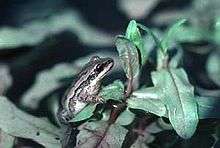Upland chorus frog
| Upland chorus frog | |
|---|---|
 | |
| Scientific classification | |
| Kingdom: | Animalia |
| Phylum: | Chordata |
| Class: | Amphibia |
| Order: | Anura |
| Family: | Hylidae |
| Genus: | Pseudacris |
| Species: | P. feriarum |
| Binomial name | |
| Pseudacris feriarum Baird, 1854 | |
| Synonyms | |
|
Pseudacris triseriata feriarum | |
The upland chorus frog (Pseudacris feriarum) is a species of chorus frog found in the United States. It was recently separated from the Western chorus frog, (Pseudacris triseriata), being identified as an individual species rather than a subspecies.
Description
Upland chorus frogs are usually brown, grey-brown, or reddish-brown in color, with darker blotching. They grow from 0.75–1.5 inches (1.9–3.8 cm) in size.
Geographic distribution
Found in the southern and eastern United States, the upland chorus frog is found from the state of New Jersey to the Florida panhandle; west to eastern Texas and southeast Oklahoma.
Behavior
 |
Upland Chorus Frog
|
| Problems playing this file? See media help. | |
Upland chorus frogs are secretive, nocturnal frogs, and are rarely seen (or heard) except immediately after rains. They are an almost entirely terrestrial species, and found in a variety of habitats, but usually moderately moist, vegetated areas, not far from a permanent water source. Like most frogs, they are insectivorous. Breeding occurs throughout the year, but most frequently during the cooler, more rainy periods from November to March. Eggs are laid in clusters of 60 or so, in water and attached to vegetation. The female can lay upwards of 1,000 eggs at a time.
Conservation status
The upland chorus frog is listed as a protected species in the state of New Jersey, primarily due to habitat destruction. Because of its restrictive habitat preferences, this species is declining in several states, particularly in areas where roadside ditches and other ephemeral pools are being drained or destroyed for new developments.
References
- Hammerson (2004). "Pseudacris feriarum". IUCN Red List of Threatened Species. Version 2006. International Union for Conservation of Nature. Retrieved 12 May 2006. Database entry includes a range map and a brief justification of why this species is of least concern.
- IUCN RangeMap: Pseudacris feriarum
- Virginia Department of Game & Inland Fisheries: Upland Chorus Frog
- Frogs and Toads of Georgia: Upland Chorus Frog
External links
- Brazos Bend State Park: Flora and Fauna / Amphibians / Upland Chorus Frog
- North Carolina Nature: Upland Chorus Frog
